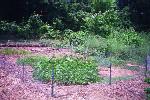Garden Chronology of Colt Mazeau
2000 (Year 2)

This year I expanded the security zone (described below) and divided it into six equally-sized
subplots with pathways between them.
Mulched as much as I could of the pathways and areas outside the fencing with leaf mulch.
I designated the security zone as the annuals section of my garden and areas outside
the security zone as the perennials section.
Established the following crop rotation scheme: half of the six subplots will be bean
crops, and the other half will be non-bean crops. The subplots are alternated so that when
I do a clockwise one-tick rotation each year, beans will replace non-beans and vice-versa.
- INVESTMENTS:
-
Leased plot, $30; chicken wire fence and fence stakes, $33;
miscellaneous seeds and supplies, $9. Total: $72
- WEEDS:
-
One problem last year was the ever-constant encroachment of large weed growth from
the two neighboring untended plots. To encourage someone to lease the plot on my
left-hand side, I made the following two-pronged maneuver. Firstly, I moved a length
of pre-existing 2" fencing so that instead of running straight along the front of the plot,
it now turns 90° and runs along the side of the plot. Secondly, I laid a swath of wood
chips along this fence to provide a right-of-way to the adjacent
plot. Happy to say, my strategy worked, and I now have a neighbor on the left-hand side.
- RODENTS:
-
Deconstructed the strand of chicken fencing, purchased another 50' strand, and put
both fences together to form a new 30' x 20' (roughly) "security zone". Seems to work well
against rodents.
- WINTER CROP RESULTS:
-
The annual ryegrass did not die over the winter as expected, but still succeeded in its job
of keeping the soil moist and preventing weed growth. I turned the soil under before the
grass became too tall.
- SUMMER CROPS PLANTED:
-
Tomatoes, carrots, peppers, dill, black beans, black-eyed peas,
lentils, poppy, sesame, caraway, anise, celery, fennel, and wheat.
The peppers did not come up at all, only a few carrots came up out of two packets, and most of
the tomatoes were offsprings from the previous year's plants. The dill and black beans did
quite well; the black-eyed peas and lentils also did nicely.
The poppy, sesame, caraway, anise, celery, and fennel seeds were
all of the variety that comes sold as a spice at the supermarket; as they did not sprout, I
presume that the processing in some way deters their growth. The wheat was healthy but did
not produce seeds.
- WINTER CROPS PLANTED:
-
Planted the following fall crops on September 15th: lettuce, radishes, and mustard. Also
planted annual ryegrass.
- PERENNIALS:
-
Discovered red potatoes; transplanted these to a new
location in the perennials section (next to the
Egyptian onions). Produced a potful of potatoes.

![]() Get your own Free Home Page
Get your own Free Home Page